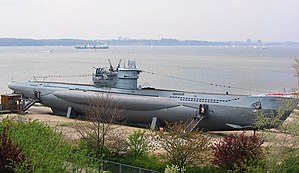German submarine U-1007
 U-995 Type VIIC/41 at the Laboe Naval Memorial. This U-boat is almost identical to U-1007.
| |
| History | |
|---|---|
| Name | U-1007 |
| Ordered | 23 March 1942 |
| Builder | Blohm & Voss, Hamburg |
| Yard number | 207 |
| Laid down | 15 February 1943 |
| Launched | 8 December 1943 |
| Commissioned | 18 January 1944 |
| Fate | Scuttled on 2 May 1945 |
| General characteristics | |
| Type | Type VIIC/41 submarine |
| Displacement | |
| Length |
|
| Beam |
|
| Height | 9.60 m (31 ft 6 in) |
| Draught | 4.74 m (15 ft 7 in) |
| Installed power |
|
| Propulsion |
|
| Speed |
|
| Range | |
| Test depth |
|
| Complement | 44-52 officers & ratings |
| Armament |
|
| Service record | |
| Part of: |
|
| Identification codes: | M 54 196 |
| Commanders: | |
| Operations: |
|
| Victories: | None |
German submarine U-1007 was a
.She was ordered on 23 March 1942, and was
Blohm & Voss, Hamburg, as yard number 207. She was launched on 8 December 1943, and commissioned under the command of Kapitänleutnant Hans Hornkohl on 18 January 1944.[6]
Design
supercharged diesel engines producing a total of 2,800 to 3,200 metric horsepower (2,060 to 2,350 kW; 2,760 to 3,160 shp) for use while surfaced, two BBC GG UB 720/8 double-acting electric motors producing a total of 750 metric horsepower (550 kW; 740 shp) for use while submerged. She had two shafts and two 1.23 m (4 ft) propellers. The boat was capable of operating at depths of up to 230 metres (750 ft).[7]
The submarine had a maximum surface speed of 17.7 knots (32.8 km/h; 20.4 mph) and a maximum submerged speed of 7.6 knots (14.1 km/h; 8.7 mph). When submerged, the boat could operate for 80 nautical miles (150 km; 92 mi) at 4 knots (7.4 km/h; 4.6 mph); when surfaced, she could travel 8,500 nautical miles (15,700 km; 9,800 mi) at 10 knots (19 km/h; 12 mph). U-1007 was fitted with five 53.3 cm (21 in)
2 cm (0.79 in) C/30 anti-aircraft guns. The boat had a complement of between forty-four and fifty-two.[7]
Service history
U-1007 participated in one war patrol which resulted in no ships damaged or sunk.[6]
On 2 May 1945, U-1007 was in the
Trave River north-east of Lübeck, 53°54′N 10°50′E / 53.900°N 10.833°E, when she was attacked by four Hawker Typhoon's of the 245th Sqn RAF piloted by F/Lt F.S. Murphy, F/O F.J. Pearson, W/O K.D. Woddan, and F/Sgt C.M. Brocklehurst. The rockets from the Typhoons badly damaged U-1007 forcing her crew to beach and scuttle her. Two of the crew died from the attack, one during and another of wounds in a hospital.[6]
The wreck was raised in May 1946 and broken up.[6]
See also
References
- ^ Helgason, Guðmundur. "Hans Hornkohl". German U-boats of WWII - uboat.net. Retrieved 19 March 2016.
- ^ Helgason, Guðmundur. "Leonhard Klingspor". German U-boats of WWII - uboat.net. Retrieved 19 March 2016.
- ^ Helgason, Guðmundur. "Helmut Wicke". German U-boats of WWII - uboat.net. Retrieved 19 March 2016.
- ^ Helgason, Guðmundur. "Karl-Heinz Raabe". German U-boats of WWII - uboat.net. Retrieved 19 March 2016.
- ^ Helgason, Guðmundur. "Ernst von Witzendorff". German U-boats of WWII - uboat.net. Retrieved 19 March 2016.
- ^ a b c d Helgason, Guðmundur. "U-1007". German U-boats of WWII - uboat.net. Retrieved 19 March 2016.
- ^ a b Gröner 1991, pp. 43–44.
Bibliography
- Busch, Rainer; Röll, Hans-Joachim (1999). German U-boat commanders of World War II : a biographical dictionary. Translated by Brooks, Geoffrey. London, Annapolis, Md: Greenhill Books, Naval Institute Press. ISBN 1-55750-186-6.
- Busch, Rainer; Röll, Hans-Joachim (1999). Deutsche U-Boot-Verluste von September 1939 bis Mai 1945 [German U-boat losses from September 1939 to May 1945]. Der U-Boot-Krieg (in German). Vol. IV. Hamburg, Berlin, Bonn: Mittler. ISBN 3-8132-0514-2.
- Gröner, Erich; Jung, Dieter; Maass, Martin (1991). German Warships 1815–1945, U-boats and Mine Warfare Vessels. Vol. 2. Translated by Thomas, Keith; Magowan, Rachel. London: Conway Maritime Press. ISBN 0-85177-593-4.
External links
- Helgason, Guðmundur. "Patrols by U-1007". German U-boats of WWII - uboat.net.
